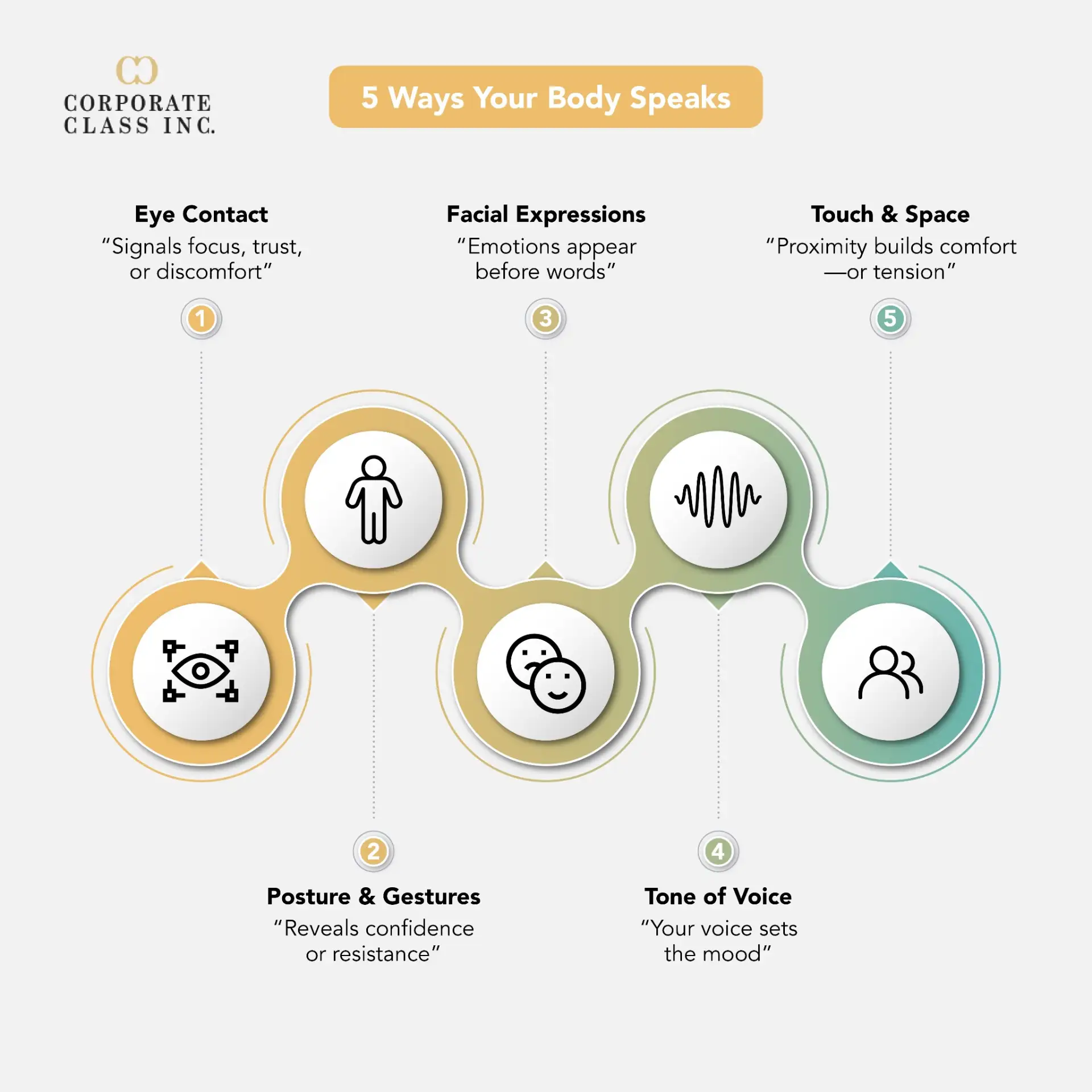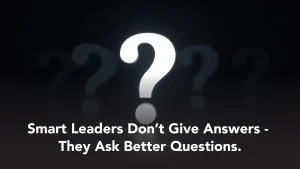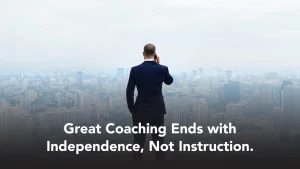Every conversation involves more than just words. Body language in communication plays a powerful role in expressing thoughts, emotions, and intentions, often louder than speech itself.
You communicate with your posture before you speak. Your eyes may give away what your mouth is still trying to decide. A shift in your stance, a pause in your movement, a single glance, each becomes part of a broader message. In fact, most people form impressions within seconds, not based on what you say, but how you say it, through facial expressions, gestures, tone, and physical space.
Understanding and mastering nonverbal communication can elevate the way you lead, collaborate, and connect. In a professional setting, it can strengthen your credibility. In personal interactions, it can create warmth, trust, or clarity when words fall short.
Key Takeaways:
- Body language is a key part of how you communicate, often shaping how your message is received.
- Reading nonverbal cues can help you understand others better and respond with empathy.
- Aligning your body language with your words builds trust and improves interpersonal communication.
What is Body Language in Communication?
Body language in communication refers to the nonverbal signals you send and receive in every interaction, consciously or not. From facial expressions to posture, your body often reveals how you truly feel, even when words say something else. Whether you’re speaking or listening, nonverbal signals create context, show engagement, and influence how others interpret your message.
Mastering this skill isn’t just for leaders or public speakers; it applies to anyone who wants to build trust, reduce misunderstandings, and strengthen their interpersonal communication.
Learn more from this executive and leadership presence workshop and discover how subtle nonverbal cues influence professional presence.
6 Ways to Communicate Through Body Language
Nonverbal communication runs alongside every word you speak. The way you hold yourself, move, or react in silence shapes how your message is perceived. Strong body language in communication often reinforces your words, while inconsistent signals can raise doubts.

Positive body language, like nodding, open posture, or relaxed facial expressions, encourages collaboration and shows confidence. Negative cues such as slouched posture, crossed arms, or lack of eye contact can create distance and confusion. Being aware of both helps you communicate clearly and with purpose.
1. Eye Contact
Where you look, how long you hold a gaze, and how often you blink can all signal attention or disinterest. Holding direct eye contact can show confidence and engagement. Blinking rapidly, looking away often, or narrowing your gaze might reveal stress or discomfort. In one-on-one conversations or meetings, steady eye contact often signals honesty and mutual respect.
2. Body Movement and Gestures
Your posture and movement shape your presence. Are you slouched in a chair or standing tall? Do your hands move naturally or stay hidden in your pockets? These actions say more than you might think.
For example:
- Excessive hand movement may signal nervous energy.
- Crossed arms might show resistance or disagreement.
- Leaning in can show interest, while leaning away may suggest discomfort.
One gesture doesn’t tell the whole story. A group of movements, what experts call gesture clusters, gives you the real message. For tips on using these signals effectively, see our guide on body language tips from expert Robert Phipps.
3. Facial Expressions
Your face often reacts before your brain catches up. Whether it’s raised eyebrows, tightened lips, or widened eyes, these cues often come out automatically. They’re also one of the few forms of communication that remain consistent across cultures.
People can’t easily fake a real emotional reaction, especially surprise, fear, joy, or sadness. That makes facial expressions one of the most trustworthy indicators of what someone is truly feeling during a conversation.
Want to sharpen your body language skills for high-stakes communication?
- Improve your executive presence
- Align your nonverbal signals with your leadership goals
- Learn from proven communication experts
4. Touch and Space
Physical distance and touch communicate boundaries and relationships. A firm handshake may suggest confidence. A hand on someone’s back could indicate reassurance or dominance, depending on the context.
Similarly, the space between two people says a lot. Sitting close may show comfort or trust. Keeping a distance could mean disinterest, caution, or discomfort. Being sensitive to these signals is part of reading interpersonal communication effectively.
5. Tone of Voice
What you say is only part of the message. How you say it completes the meaning.
Pitch, pace, volume, and rhythm can change the emotional tone of your words. A calm, steady tone can express professionalism. A shaky voice may signal anxiety. Matching your tone to your intention helps others feel understood and respected, especially in emotionally charged situations.
Whether you’re speaking at a funeral, giving feedback at work, or chatting with a friend, adjusting your tone shows emotional awareness.
6 Aligning Body Language With Verbal Communication
When your words and body language don’t match, people often trust the nonverbal message. Saying “I’m fine” while avoiding eye contact and crossing your arms usually doesn’t convince anyone. These mismatches can cause others to doubt your sincerity.
In contrast, when your nonverbal and verbal messages support each other, you come across as more honest and credible. This is especially important in team meetings, negotiations, and leadership communication. Clear body language strengthens interpersonal communication by removing ambiguity and building a connection.
Why Body Language in Interpersonal Communication Matters
Body language in interpersonal communication builds trust or breaks it. Whether you’re having a personal discussion or a professional meeting, these cues shape how people perceive your intentions.
Developing awareness of your own gestures, posture, and expressions can improve how others experience your presence. At the same time, learning to read nonverbal communication from others can help you respond more thoughtfully. This is particularly valuable in high-emotion moments, where words alone don’t paint the full picture.
Discover how to use body language to captivate, connect, and communicate effectively.
- Learn body language presentation strategies
- Understand the signals your audience responds to
- Build rapport without saying a word
How to Improve Your Body Language Awareness
If you’re unsure how others see you, start by recording yourself in casual and professional settings. Review the footage and look for patterns: Do you avoid eye contact? Do you smile when appropriate? Is your posture relaxed or tense?
You can also:
- Ask for feedback from trusted peers or mentors
- Practice in front of a mirror
- Take part in communication skills workshops
The goal isn’t to fake confidence but to build awareness. Once you understand how your body communicates, you can adjust your habits to strengthen your interpersonal communication naturally.
Adapting Body Language in Communication
Body language in communication is constant. It influences how you’re understood, trusted, and remembered. By tuning into your nonverbal habits and observing others with care, you can create stronger relationships, both personally and professionally.
Developing this awareness isn’t about performing. It’s about connecting. When your actions align with your words, you’re more likely to be seen, heard, and believed.
Ready to assess and refine your body language?
- Get real-time coaching
- Build authentic presence
- Learn what your body is saying





